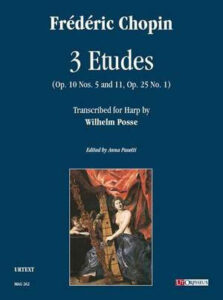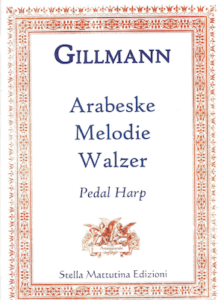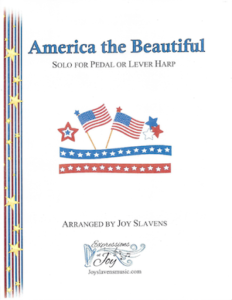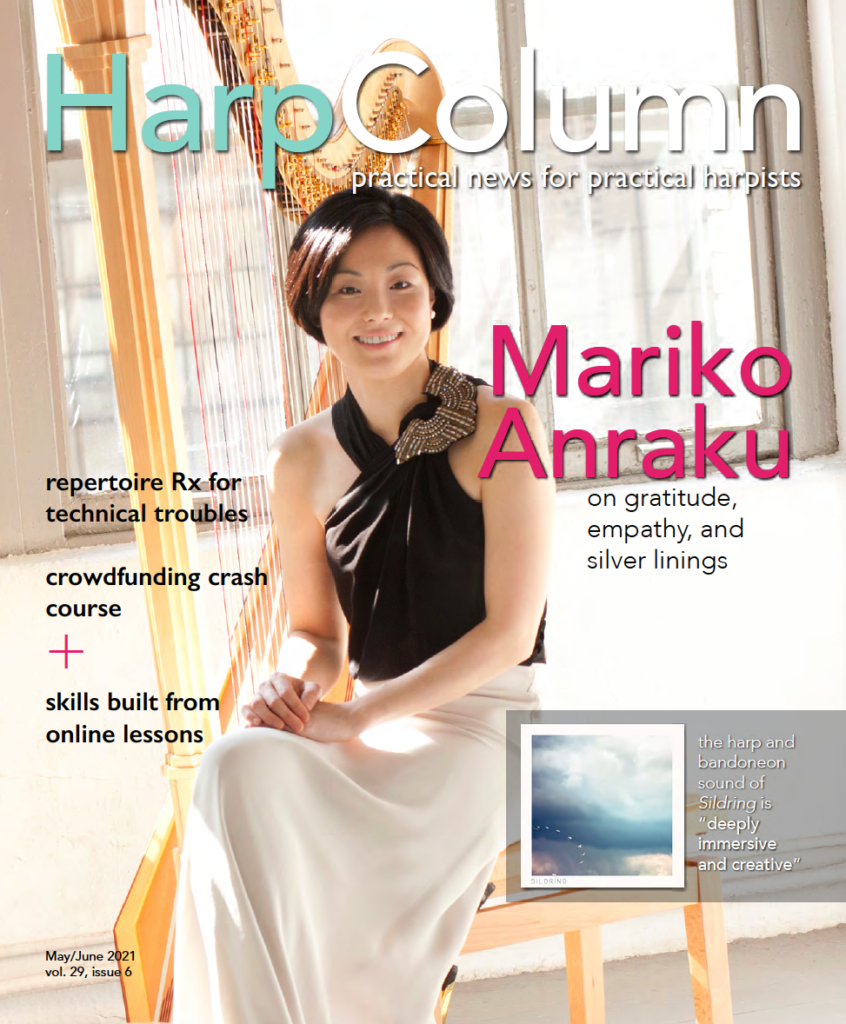
Thank goodness for transcriptions. We get to play music written for other instruments—like the piano—but it is often even more difficult on the harp with two fewer fingers and many more pedals to move for accidentals. Such is the case with many Chopin etudes and compositions. Alphonse Hasselmans transcribed and published Chopin’s popular Valse op. 64, no. 1 around 1910. This version is newly edited by Anna Pasetti and published by UtOrpheus. She states in the preface that the use of accidentals was modernized, but otherwise the musical text was kept as close as possible to the original. This edition is lovely, but since pedal changes were often not included back then, Pasetti could have greatly enhanced and modernized this publication by including the frequent pedal changes.
Chopin originally wrote the piece in D-flat but Hasselmans transposed it to E-flat to make the pedals more accessible. Nevertheless, it requires a lot of pedal work, and only one pedal change is notated in measure 47. There are a few markings in solfege for some enharmonic substitutions in measures 35, 52, 64, and 107. The fast and frequent pedal changes and the speed at which the music is supposed to be played makes this suitable for the upper intermediate or advanced player, and certainly worth the effort.

UtOrpheus has also re-published Wilhelm Posse’s transcriptions of 3 Etudes (op. 10, nos. 5 and 11, and op. 25, no. 1) by Chopin. Most pedals are included in the middle of the staff. Again, Pasetti has kept the musical text close to the original, but could have added to the value by updating the missing pedal markings. The most noticeable difference from the original 1919 Zimmerman edition is the typesetting isn’t as crowded.
I have never heard any harpist play the first two etudes, op. 10, no. 5 (“Black Keys”) and no. 11. The piano recordings by such great artists as Vladimir Horowitz and Lang Lang are impressive. We can hope this new edition will inspire some advanced harpists to tackle this gorgeous music. The last etude in the group, op. 25, no. 1, is known as the “Aeolian Harp” etude. Some of our finest harpists have mastered and recorded it, notably Elizabeth Hainen and Alexander Boldachev. For my money, this is the most beautiful etude ever written, and it is even more stunning on harp than piano.

Gillmann is a new publication from publisher Stella Mattutina Edizioni. Kurt Gillmann, 1889–1975, was a German harpist and composer who was principal harp with the Hannover Opera Theater. Subsequently, he was director of the Opera Theater in Schwerin and later became harp professor at the Musical Academy of Berlin Charlottenburg. All of his compositions were written before 1945 and were lost during World War II. In 1959, he decided to commit to reconstructing his lost works. Unfortunately, he went blind and was unable to complete this goal. If his name is not familiar to you, you are not alone, and that may be due in large part to the loss of so much of his work.
Harpist Katia Catarci was introduced to Gillmann’s work by her teacher, Ofelia Guglielmi, harp professor at the Santa Cecilia Conservatory in Rome. Catarci had three short pieces published and dedicated them to the memory of her teacher.
The first of these is the lovely “Arabeske, op. 15.” It is just three pages in length and features flowing sextuplets throughout in the right hand. The melody is primarily in the left hand and the key signature of G-flat takes full advantage of the rich sonority of the harp.
“Melodie, op. 10” is the next piece written in all seven flats. Gillmann must have liked not only the sound of the open strings, but also the deep bass tones as some sections are in the lower registers.
The flashy finale to this trio is “Walzer, op. 25,” and it is also the longest. Gillmann used big, rippling chords, some fast arpeggios, a B section in a different key, and several recaps to the early theme.
All three works contain quite a few pedal changes and none are notated except for a few random markings in the waltz. Perhaps it is a tradition in Italian publishing not to notate pedals? Pedal markings would have made this music more readily accessible, but it is not excessively difficult. Fingering is not suggested either, but upper intermediate and advanced players may prefer to do their own. We are fortunate that Guglielmi and Catarci have brought the creations of Kurt Gillmann to our attention.

If you want a break from all those pedals, Diana Stork has published Harp Crossings, from North to South America and Back Again. There are a total of 11 tunes for Latin, lever, and pedal harps. All but one are original compositions by Stork. The exception is a traditional Venezuelan piece, “Lamento Apureño.” It is presented twice: once arranged by Carlos Guedes in C major and the other by Stork in a minor key.
There are some pre-set levers and pedals in a few of the selections, but almost no accidentals. There is one short section in “Midnight Calling” where Stork wants you to raise the Cs to sharp at the end of the piece. It is notated for lever harp simply by the words “raise C#’s” and for pedal harp with a C# in a box below the staff.
Two pieces, “St. Martin’s Tango” and “Campanas de Boda (Wedding Bells)” are offered as both solos and in duet form. (The duet version is definitely more fun to play!)
Stork uses several special effects such as harmonics, étouffées, nail and scale glisses, and tapping on the soundboard to add interest to the arrangements. There is a glossary of special techniques in the front of the book. She encourages you to improvise on her music and in certain pieces, such as “Breezes Over Brezo,” or “Two Seas,” she instructs you to improvise in a specific section. In those cases, she provides the chords in the middle of the staff to assist. Once you purchase the book, you are given a password so that you can hear Stork playing each piece on her website. I don’t know if you can preview it before purchase, but most of this music is not difficult to play and could add a Latin flavor to your repertoire. Stork suggests in the foreword that there has never been a better time or way to bridge our cultures than through music, and if you share that vision, you will probably enjoy playing this music.

Since Independence Day will be here in a matter of weeks, you may want to start preparing some patriotic music for the occasion of our nation’s 245th birthday. Joy Slavens has arranged and published two versions of “America the Beautiful” for solo harp. She describes one as early advanced for solo pedal harp and the other is an easier version for either lever or pedal harp.
The simpler version has two verses and one C lever that needs to be moved in each verse. A diamond-shaped note indicates the change. There is no pedal notation. It is in the key of C and can be played on a lever harp tuned with three or fewer flats. The intervals of tenths provide nice harmony in the left hand chords that alternate with an arpeggiated accompaniment. Intermediate players should be able to sightread this, but it doesn’t sound simplistic.
The pedal harp solo begins with an introduction of glisses that requires several pedal changes that are notated below the staff. It starts in B-flat and modulates to the key of C for the second verse. Several pedal changes provide lush harmonies, but none are difficult. A few harmonies felt unresolved, like the suspension in measure 38 that just begged to be turned into a C7. But this is music, not the gospel, so you are free to do your own resolution if you feel so moved. There are some scale glisses, a few fast arpeggios, and one quick page turn. The finale features a bunch of C major glisses. It is definitely more advanced than the previously mentioned version, but still readily playable for an intermediate player. •
Jan Jennings has been the music review editor for Harp Column since 1993. She is an active freelancer and teacher, and is the author of The Harpist’s Complete Wedding Guidebook and Effortless Glissing. Email her at
mail@harpbiz.com.







